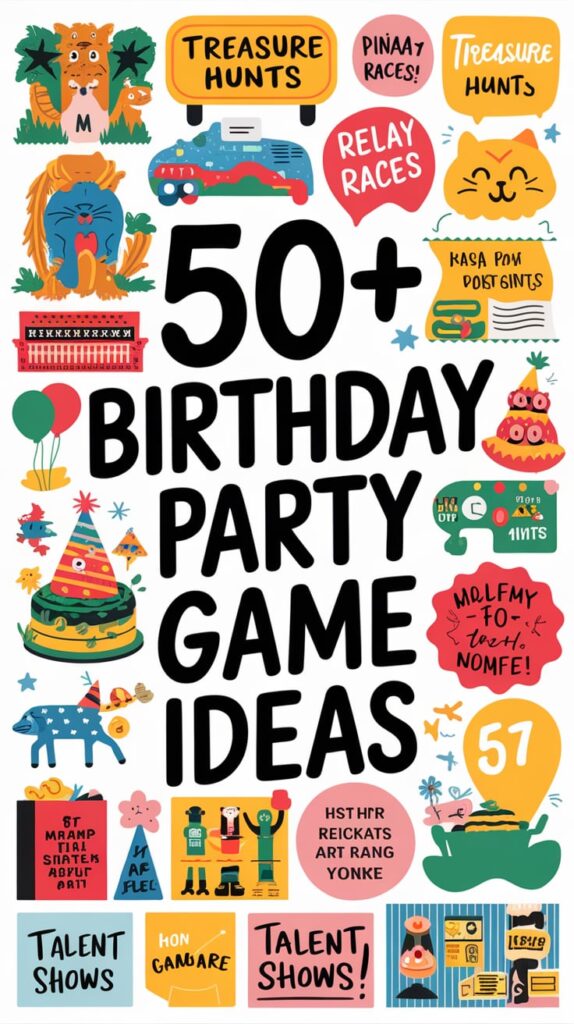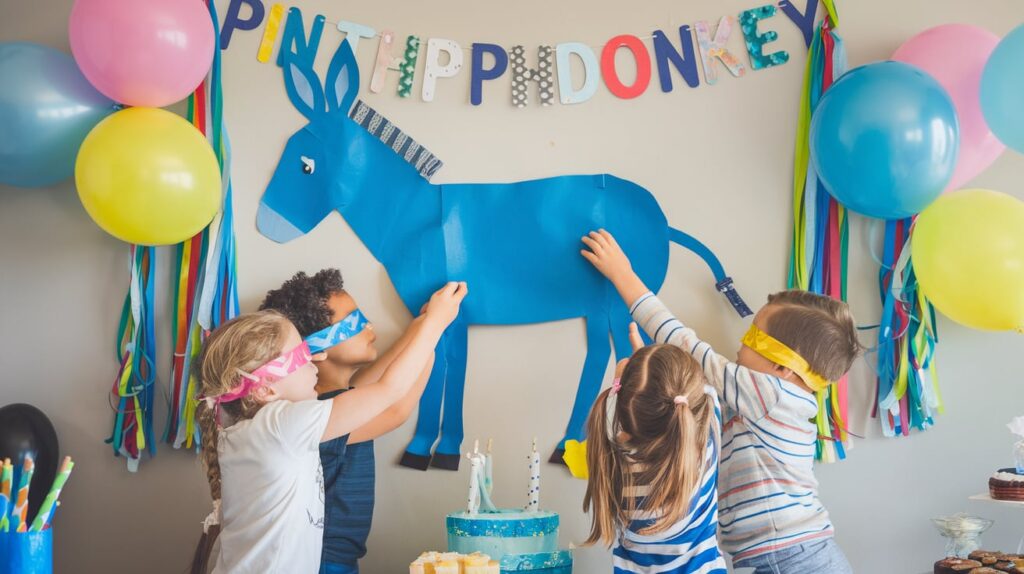Birthday Party Game Ideas can transform an ordinary celebration into an unforgettable experience filled with laughter and engagement. From classic favorites like “Musical Chairs” and “Pin the Tail on the Donkey” to modern twists like a scavenger hunt or trivia game tailored to the birthday person’s interests, there are countless options to suit various age groups and themes.
Interactive games like a DIY photo booth with props encourage creativity and capture memories, while relay races can add a competitive spirit among guests. For a more laid-back vibe, consider card games or board games that invite conversation and camaraderie. The key is to choose activities that resonate with the birthday honoree and create a joyful atmosphere, ensuring that everyone leaves with cherished memories of the day.
Related Post –
Birthday Party Game Ideas
Here are the top 10 best birthday party games:
- Musical Chairs
- Pin the Tail on the Donkey
- Scavenger Hunt
- Treasure Hunt
- Balloon Pop Relay
- Birthday Bingo
- Guess the Number of Candies
- Simon Says
- Karaoke Contest
- Charades
Musical Chairs
Musical Chairs is a classic party game that combines music, movement, and a bit of friendly competition, making it a favorite for birthday celebrations and other gatherings. The game is simple to set up and play, ensuring that participants of all ages can join in on the fun.
How to Play Musical Chairs Step by Step:
Step 1: Gather Materials
- Chairs: Arrange a sufficient number of chairs in a circle, ensuring there’s one fewer chair than the number of participants. For example, if you have 10 players, set up 9 chairs.
- Music Source: Prepare a device to play music, such as a speaker or a smartphone with a playlist. Choose upbeat and engaging songs to maintain a lively atmosphere.
Step 2: Explain the Rules
- Before starting, gather the players and explain the objective of the game: to find a seat when the music stops. Stress that players must always be ready to move quickly and stay alert to the music.
Step 3: Position the Chairs
- Set the chairs in a circle, facing outward. Make sure they are spaced evenly to allow players to move freely between them. The arrangement should ensure that everyone can reach a chair easily when the music stops.
Step 4: Start the Music
- Have all players stand around the chairs, facing inward. Begin playing the music and instruct players to walk around the chairs in a clockwise direction. Encourage them to move to the rhythm and have fun.
Step 5: Stop the Music
- Randomly stop the music at any point. Players must immediately find a chair and sit down. Since there’s one less chair than there are players, one person will be left standing.
Step 6: Eliminate Players
- The player who is unable to find a seat is eliminated from the game. They can cheer on the remaining participants or help with the music for the next round.
Step 7: Remove a Chair
- After each round, remove one chair from the circle before restarting the music. This ensures that each subsequent round becomes more competitive, as fewer seats are available.
Step 8: Continue Playing
- Repeat the process of playing music, stopping it, and having players find seats. Continue eliminating players until only two remain.
Step 9: Final Round
- In the final round, the last two players will compete for the remaining chair. When the music stops, whoever sits first wins the game!
Step 10: Celebrate the Winner
- Congratulate the winner and consider giving a small prize or reward for their victory. This adds a fun element of recognition and encourages friendly competition.
Tips for a Successful Game:
- Adjust for Age Groups: If playing with younger children, consider slowing down the music to give them more time to find a seat. For older participants, you can increase the pace to add excitement.
- Use Creative Music Choices: Choose a mix of popular songs, nostalgic tunes, or themed music to keep the game lively and engaging.
- Create a Fun Atmosphere: Encourage participants to get creative with their movements and expressions while walking around the chairs. This adds to the fun and keeps everyone entertained.
Musical Chairs is a timeless game that fosters laughter, excitement, and a little bit of suspense, making it a perfect addition to any birthday party or festive gathering!
Pin the Tail on the Donkey
Pin the Tail on the Donkey is a delightful and classic party game that brings a playful spirit to any birthday celebration. It combines blindfolded fun and a bit of skill, making it a favorite among children and adults alike.
How to Play Pin the Tail on the Donkey Step by Step:
Step 1: Gather Materials
- Donkey Poster: Obtain or create a large poster of a donkey. Ensure it is prominently displayed on a wall.
- Tail: Create a tail using a piece of fabric or paper, attaching a pin or tape at one end for easy fastening.
- Blindfold: Use a scarf or any piece of fabric to blindfold players.
- Marker: Optionally, have a marker handy for players to write their names on their tails.
Step 2: Set Up the Game Area
- Hang the donkey poster at a height accessible for all players. Make sure it’s securely attached to the wall to prevent it from falling during the game.
Step 3: Explain the Rules
- Gather the participants and explain the objective: to pin the tail as close to the correct spot on the donkey as possible while blindfolded. Clarify that players will take turns and emphasize the fun and silliness of the game.
Step 4: Choose the Order of Play
- Decide the order in which players will take their turns. You can do this randomly or let players volunteer.
Step 5: Blindfold the Player
- When it’s a player’s turn, securely place the blindfold over their eyes. Ensure they cannot see and that they are comfortable with it on.
Step 6: Spin the Player
- Gently spin the blindfolded player around 2-3 times to disorient them slightly. This adds a fun challenge and a few laughs.
Step 7: Guide the Player
- After spinning, point the player in the direction of the donkey poster. Players can take a few steps forward, but ensure they stay aware of their surroundings to avoid bumping into anything.
Step 8: Pin the Tail
- Once the player feels they are near the donkey, they can attempt to pin the tail on the poster. They can reach out and try to stick it as close to the donkey’s rear as possible.
Step 9: Remove the Blindfold
- After the player pins the tail, remove the blindfold and see how close they got to the target. This often results in laughter and playful teasing as everyone checks the placement.
Step 10: Keep Score (Optional)
- If desired, keep track of the players’ scores based on how close they placed the tail to the correct spot. You can award points or simply play for fun without keeping score.
Step 11: Rotate Turns
- Allow each player to take their turn until everyone has had a chance to pin the tail.
Step 12: Celebrate the Winner
- After everyone has played, determine who placed their tail closest to the correct spot. Celebrate the winner with applause and consider giving a small prize or certificate for their achievement.
Tips for a Successful Game:
- Create a Themed Tail: For a more personalized touch, make the tail match the theme of the party, such as a character from a favorite movie or a colorful fabric.
- Adapt for Age Groups: If playing with younger children, you might want to reduce the spinning to keep them steady and avoid dizziness.
- Use Creative Blindfolds: Get creative with blindfolds—use funny masks or themed fabric to add to the fun and silliness of the game.
Pin the Tail on the Donkey is an entertaining and engaging activity that encourages laughter, friendly competition, and a sense of nostalgia, making it a perfect addition to any birthday party or festive gathering!
Scavenger Hunt
Scavenger Hunt is an exhilarating and interactive game that encourages participants to explore their surroundings while searching for specific items or completing fun tasks. This game can be tailored to fit various themes and locations, making it a versatile choice for birthday parties, family gatherings, or community events.
How to Play Scavenger Hunt Step by Step:
Step 1: Plan the Hunt
- Choose a Location: Decide where the scavenger hunt will take place—this could be indoors (like a home or classroom) or outdoors (such as a park or backyard). Ensure the area is safe and suitable for participants.
- Select a Theme: Consider choosing a theme for the scavenger hunt, such as nature, holidays, or a specific event. This can add an extra layer of excitement and engagement.
Step 2: Create a List
- Compile Items or Tasks: Make a list of items that players must find or tasks they need to complete. Include a mix of easy and challenging items to keep it interesting. For example, the list might include a pinecone, a red leaf, or a photo of a team member doing a funny pose.
- Format the List: Print or write out the lists for each team or player. You might also consider creating riddles or clues to lead players to certain items.
Step 3: Organize Teams
- Divide Participants: Depending on the number of players, split them into teams or allow individuals to compete. Ensure each team has a good mix of skills and ages for balance.
- Distribute Materials: Hand out the scavenger hunt lists, writing materials, and any necessary tools (like bags for collecting items).
Step 4: Explain the Rules
- Outline Objectives: Clearly explain how the scavenger hunt works. Participants will have a set amount of time to find as many items as possible from the list or complete the assigned tasks.
- Set Boundaries: Specify the area where players can search to keep everyone safe and ensure no one wanders too far.
Step 5: Start the Hunt
- Set a Timer: Give participants a designated amount of time to complete the scavenger hunt, such as 30 minutes to an hour. Announce the start of the game with a countdown to build anticipation.
- Encourage Teamwork: Remind players to work together, communicate, and strategize effectively as they search for items or complete tasks.
Step 6: Collect Items and Complete Tasks
- Search for Items: Teams will race against the clock, searching for the items on their lists and marking off what they find. If tasks are included, they can complete them and take photos or collect evidence.
- Stay Engaged: Encourage participants to keep their energy up and have fun. Play upbeat music or offer incentives for teamwork to maintain enthusiasm.
Step 7: Time’s Up
- Conclude the Hunt: Once the timer goes off, gather all participants back at a designated meeting point. Ensure everyone stops what they’re doing and returns to the starting point.
Step 8: Review Findings
- Check Lists: Each team will present their findings, and players can share stories about their adventures. Review the lists together and tally the points for each item found or task completed.
- Celebrate Creativity: If photos were taken for tasks, display them for everyone to enjoy, as they often bring laughter and fond memories.
Step 9: Declare Winners
- Announce Results: Determine which team found the most items or completed the most tasks within the allotted time. You can award points for creativity, teamwork, or completing specific challenges.
- Prizes (Optional): Consider giving small prizes or certificates to the winning team and recognizing everyone for their participation.
Tips for a Successful Game:
- Customize for Age Groups: Tailor the difficulty of the items or tasks based on the ages of the participants. Younger kids may enjoy simpler scavenger hunts, while older participants can handle more complex challenges.
- Incorporate Local Culture: If the scavenger hunt is set in a specific location, include items or tasks that reflect local culture or landmarks for added interest.
- Be Flexible: Prepare for the unexpected by allowing teams to swap items or tasks if they’re having difficulty. This promotes collaboration and keeps the game fun.
Scavenger Hunt is an entertaining and engaging activity that fosters teamwork, creativity, and exploration, making it an ideal choice for any celebration or gathering!
Treasure Hunt
Treasure Hunt is an adventurous and thrilling game that combines problem-solving, teamwork, and exploration. Players embark on a quest to uncover hidden treasures by following clues and solving riddles. This game can be adapted for various settings, making it perfect for birthday parties, family gatherings, or educational activities.
How to Play Treasure Hunt Step by Step:
Step 1: Plan the Hunt
- Select a Location: Choose a suitable area for the treasure hunt, such as a backyard, park, or even an indoor space. Ensure it’s safe and has enough room for players to explore.
- Determine the Treasure: Decide what the treasure will be. It could be a small prize, treats, or a treasure chest filled with goodies. Make sure it’s appealing to the participants.
Step 2: Create Clues
- Develop a Clue List: Craft a series of clues or riddles that lead participants from one location to another, eventually leading them to the treasure. Each clue should be engaging and appropriately challenging.
- Use Different Formats: Incorporate various types of clues, such as written riddles, maps, or visual puzzles, to keep the game dynamic and exciting.
Step 3: Set Up the Game
- Hide the Treasure: Securely hide the treasure in a location that is not too obvious but accessible for players.
- Place Clues: Strategically position each clue at different locations, ensuring they logically lead from one to the next. Consider including a clue with directions for finding the next one.
Step 4: Organize Teams
- Divide Participants: Depending on the number of players, create teams or let individuals play solo. Make sure the groups are balanced and have a mix of skills.
- Provide Materials: Distribute any necessary materials, such as paper for notes, writing utensils, and bags for collecting items.
Step 5: Explain the Rules
- Outline Objectives: Clearly explain the game’s objective: to follow the clues, solve the riddles, and reach the treasure first. Emphasize the importance of teamwork and communication.
- Set Boundaries: Specify the play area to ensure everyone stays safe and doesn’t wander too far.
Step 6: Start the Hunt
- Kick Off the Adventure: Begin the treasure hunt with an enthusiastic announcement. Hand out the first clue to each team or player.
- Encourage Exploration: Motivate participants to explore their surroundings, think creatively, and collaborate effectively to solve the clues.
Step 7: Follow the Clues
- Solve the Riddles: Teams will work together to decipher each clue and navigate to the next location. Encourage them to think outside the box and share ideas.
- Stay Engaged: Keep spirits high by playing background music or offering little challenges along the way, such as mini-games or trivia related to the treasure hunt theme.
Step 8: Locate the Treasure
- Reach the Final Destination: As teams solve the clues, they will ultimately arrive at the treasure’s hiding place. Ensure that the final location is well-marked or identifiable.
- Celebrate the Discovery: When a team finds the treasure, celebrate their achievement! Allow them to enjoy their spoils and take pictures of the moment.
Step 9: Conclude the Game
- Gather All Participants: After the treasure is found, bring everyone together to share their experiences and the fun moments during the hunt.
- Share Clues and Stories: Allow teams to recount how they solved the clues and what strategies worked best for them. This creates a sense of camaraderie and enjoyment among all players.
Step 10: Award Prizes (Optional)
- Recognize Achievements: Consider giving small prizes to the winning team or everyone who participated, ensuring that each player feels valued for their efforts.
Tips for a Successful Game:
- Customize Clues: Tailor the clues based on the age group of the participants. Younger children may benefit from simpler clues, while older players can handle more complex riddles.
- Incorporate Themes: If the treasure hunt is for a specific event, consider using a theme (like pirates, detectives, or holidays) to enhance engagement.
- Be Flexible: Be ready to assist teams if they struggle with clues or directions. Encouragement and hints can maintain the game’s momentum and enjoyment.
Treasure Hunt is an exciting and interactive activity that encourages teamwork, critical thinking, and exploration, making it a fantastic choice for any gathering or celebration!
Balloon Pop Relay
Balloon Pop Relay is an energetic and lively game that adds a burst of fun to any party or event. It combines the excitement of a relay race with the playful challenge of popping balloons, making it perfect for children and adults alike.
How to Play Balloon Pop Relay Step by Step:
Step 1: Gather Materials
- Balloons: Collect a sufficient number of balloons, preferably in various bright colors. Make sure to have extra balloons on hand in case some pop before the game begins.
- A Flat Surface: Find an open area or space where players can safely run without obstacles.
- Markers: If you want to designate teams, consider using markers to assign colors or symbols to each team.
Step 2: Set Up the Game Area
- Define Starting and Ending Points: Mark a clear starting line and a finish line about 10-15 feet apart. The distance can be adjusted based on the players’ age and skill level.
- Divide Teams: Split participants into two or more teams, ensuring that each team has an equal number of players to keep it fair.
Step 3: Explain the Rules
- Objective: The goal of the game is for each team member to race to the finish line while popping a balloon along the way and then return to tag the next teammate.
- Popping Method: Specify how participants should pop the balloons. Common methods include sitting on them, stomping on them, or using their hands. Make sure all players are aware of the popping technique to prevent any accidents.
Step 4: Distribute Balloons
- Provide Balloons to Each Team: Hand out one balloon per player for the relay. Alternatively, you can place a pile of balloons at the starting line for players to choose from as they run.
Step 5: Start the Game
- Set the Countdown: Gather all players at the starting line and explain the game one final time. Then, on the count of three, signal the start of the relay.
- Teams Race: The first player from each team runs to the designated finish line with their balloon, pops it using the agreed-upon method, and then races back to tag the next teammate.
Step 6: Tagging and Continuing
- Tagging: Upon returning, the player tags the next teammate, who then repeats the process. The relay continues with each team member taking turns running, popping a balloon, and tagging the next player.
- Team Coordination: Encourage players to cheer for their teammates and stay enthusiastic throughout the game to build camaraderie.
Step 7: Conclude the Relay
- Finish Line: The game continues until all members of a team have successfully popped their balloons and returned to the starting point.
- Determine the Winner: The first team to have all their members complete the relay is declared the winner.
Step 8: Celebrate Participation
- Applaud Everyone: Regardless of which team wins, celebrate everyone’s participation and effort. This fosters a spirit of fun and friendly competition.
- Optional Prizes: If desired, award small prizes or certificates to the winning team or simply offer fun accolades like “Balloon Poppers of the Day!”
Tips for a Successful Game:
- Safety First: Ensure the play area is clear of any sharp objects or hazards that could pose a risk to players while they run.
- Adjust for Age: Tailor the distance and balloon-popping method based on the age group. For younger kids, you might want to make the distance shorter or allow them to pop the balloon with their hands.
- Keep It Lighthearted: Emphasize fun over competitiveness, encouraging laughter and enjoyment throughout the game.
Balloon Pop Relay is a thrilling game that promotes physical activity, teamwork, and lots of laughter, making it an excellent addition to any gathering or celebration!
Birthday Bingo
Birthday Bingo is a lively and interactive party game that adds an exciting twist to the traditional bingo format, perfect for celebrating birthdays. This game encourages social interaction, laughter, and friendly competition among guests, making it an ideal addition to any birthday celebration.
How to Play Birthday Bingo Step by Step:
Step 1: Prepare the Bingo Cards
- Create Unique Cards: Design bingo cards with a 5×5 grid format. Instead of traditional numbers, fill each square with birthday-themed words or phrases, such as “cake,” “presents,” “party hat,” “balloons,” or “candles.” You can also include fun activities related to the birthday celebration.
- Distribute Cards: Print out enough unique bingo cards for each participant. Ensure that no two cards are identical to keep the game interesting.
Step 2: Gather Materials
- Bingo Markers: Provide markers, chips, or even small candies that players can use to mark off their bingo cards when they hear the corresponding words.
- Caller’s List: Prepare a list of the words or phrases used in the bingo cards for the person who will call out the items during the game.
Step 3: Explain the Rules
- Outline the Objective: Explain to the participants that the goal is to be the first to complete a designated pattern on their bingo card (e.g., a straight line, diagonal line, or full card) by marking off the words as they are called out.
- Clarify Winning Conditions: Let players know how they will call out “Bingo!” when they’ve achieved the winning pattern. Make sure to clarify whether they should raise their hands or shout out to get attention.
Step 4: Start the Game
- Gather Everyone: Once everyone has their bingo cards and markers, bring all participants together in a comfortable space to ensure everyone can hear the caller.
- Select a Caller: Choose a person to be the bingo caller. This could be the birthday person, a family member, or a friend who is enthusiastic about leading the game.
Step 5: Call Out the Items
- Begin Calling: The caller will randomly select items from their prepared list and call them out loud for everyone to hear. As each word is called, players look at their bingo cards and mark off the corresponding square if they have it.
- Encourage Participation: Create a lively atmosphere by encouraging players to react when they have marked an item. You might even have everyone repeat the word after it’s called for added engagement.
Step 6: Check for Bingo
- Announce “Bingo!”: When a player completes the designated pattern, they shout “Bingo!” to alert the caller and the other participants.
- Verify the Win: The caller will then ask the player to confirm their winning pattern by reading out the marked items on their card. This ensures fairness and verifies the win.
Step 7: Reward the Winner
- Celebrate the Winner: Once the bingo has been confirmed, recognize the winner with applause and consider providing a small prize, such as a party favor or a birthday-themed gift.
- Continue Playing (Optional): Depending on the group’s interest, you can play multiple rounds of Birthday Bingo. You may want to change up the patterns required for winning in each round, such as “four corners” or “blackout” (marking the entire card).
Step 8: Wrap Up the Game
- Thank Participants: At the end of the game, thank everyone for playing and encourage them to continue enjoying the birthday festivities.
- Gather Feedback: If you have time, ask players what they enjoyed about the game or if they have suggestions for future birthday bingo themes or items.
Tips for a Successful Game:
- Customize for the Birthday Person: Include personal touches related to the birthday person, such as their favorite foods, hobbies, or memories, to make the game even more special and relevant.
- Engage Everyone: If the party includes guests of different ages, consider having a separate bingo game for kids and adults to ensure everyone has a chance to enjoy the game.
- Use Creative Bingo Cards: To make the game more visually appealing, consider designing colorful bingo cards or including themed graphics that match the party decorations.
Birthday Bingo is a delightful and engaging activity that brings guests together for fun, laughter, and celebration, making it a perfect addition to any birthday party!
Guess the Number of Candies
Guess the Number of Candies is a simple yet engaging game that adds an element of excitement and suspense to any gathering. This game is perfect for parties, classrooms, or family events, providing a fun way to challenge participants’ estimation skills.
How to Play Guess the Number of Candies Step by Step:
Step 1: Gather Materials
- Container: Choose a clear jar or container to hold the candies. This visibility will intrigue participants and allow them to see the candies without counting them.
- Candies: Fill the container with a variety of candies. The more colorful and diverse, the better! Ensure that the jar is filled enough to make guessing challenging but not overwhelming.
Step 2: Set Up the Game Area
- Display the Jar: Place the jar in a prominent location where all participants can easily see it. Make sure it’s accessible for everyone to observe the candies without touching the jar.
Step 3: Explain the Rules
- Overview of the Game: Gather participants and explain the objective: to guess the total number of candies in the jar. Clarify that they will write down their guesses without counting the candies directly.
- Guidelines for Guessing: Set any necessary guidelines, such as the time limit for making guesses or whether participants can ask questions about the jar or candies.
Step 4: Provide Materials for Guessing
- Guessing Slips: Hand out slips of paper or index cards for participants to write their guesses on. Provide pens or pencils so everyone can easily record their answers.
- Collecting Names: Ask participants to include their names on their slips so you can identify the guessers later.
Step 5: Start the Game
- Encourage Participation: Let participants know they can take their time to think carefully about their guesses. Encourage discussions among friends to promote engagement and excitement.
- Set a Time Limit: Allow a reasonable time frame for guesses, such as 5-10 minutes, to keep the game moving while giving enough time for thoughtful estimations.
Step 6: Collect Guesses
- Gather the Slips: Once the time is up, collect all the slips of paper with participants’ guesses. Ensure each guess is accounted for and that all participants have had a chance to submit their answers.
Step 7: Reveal the Actual Count
- Count the Candies: Carefully count the total number of candies in the jar. You might want to do this in front of the participants for added excitement and transparency.
- Announce the Number: Once the candies are counted, announce the actual total to all participants, building anticipation.
Step 8: Determine the Winner
- Compare Guesses: Check the guesses against the actual number of candies. The participant whose guess is closest to the actual count without going over is declared the winner.
- Multiple Winners (Optional): If desired, you can recognize multiple participants who guessed closely, especially if the guesses are particularly close together.
Step 9: Reward the Winner
- Prizes: Consider giving a small prize to the winner, such as a bag of candies, a gift card, or a fun party favor. This adds an element of competition and motivation to participate.
- Celebrate Participation: Acknowledge everyone’s guesses and encourage them to join in future games, ensuring that everyone feels included and valued.
Tips for a Successful Game:
- Choose Unique Candies: Use a variety of candies, including some that might be less common, to make guessing more intriguing.
- Adjust for Difficulty: Depending on the age of the participants, you can adjust the size of the jar and the number of candies to make the game easier or more challenging.
- Encourage Creativity: Allow participants to come up with creative guesses, and consider offering additional prizes for the most imaginative guesses.
Guess the Number of Candies is an entertaining and interactive game that encourages friendly competition and camaraderie, making it a delightful addition to any event!
Simon Says
Simon Says is a classic game that combines listening skills, quick thinking, and a whole lot of fun. It’s a fantastic activity for parties, classrooms, and family gatherings, making it suitable for players of all ages.
How to Play Simon Says Step by Step:
Step 1: Gather Players
- Assemble a group of participants. The game works best with at least three players but can accommodate larger groups for added excitement.
Step 2: Select a Leader
- Choose one player to be “Simon.” This person will give commands for the rest of the players to follow. If you have many players, you can rotate the role of Simon after a few rounds.
Step 3: Explain the Rules
- Explain that players must only follow commands that start with the phrase “Simon says.” If Simon gives a command without saying this phrase, players should not follow it. Clarify that players who follow a command without hearing “Simon says” are out of the game.
Step 4: Start the Game
- Have all players stand in a designated area, facing Simon. The leader can begin giving commands in a clear and engaging manner.
Step 5: Give Commands
- Simon will call out various actions for the players to perform, such as:
- “Simon says touch your toes.”
- “Simon says jump up and down.”
- “Simon says spin around.”
- Commands should be simple and easy to follow, encouraging movement and interaction.
Step 6: Catch Players Off Guard
- To keep the game interesting, Simon can give commands without saying “Simon says.” For example:
- “Clap your hands.”
- Players who respond to this command are eliminated from the game. This encourages players to listen carefully and pay attention.
Step 7: Continue the Game
- Simon can vary the pace and complexity of commands to keep everyone engaged. Continue giving commands until only one player remains or for a set amount of time.
Step 8: Celebrate the Winner
- Once players are eliminated, the last person remaining becomes the winner. Celebrate their victory with cheers and applause!
Step 9: Rotate Roles (Optional)
- If desired, allow the winner or a different player to take on the role of Simon for the next round, keeping the game fresh and exciting.
Tips for a Successful Game:
- Be Creative with Commands: Mix in fun and silly commands, such as “Simon says pretend to be a chicken” or “Simon says walk like a crab.” This adds humor and keeps players entertained.
- Use Variations for Different Ages: For younger children, keep commands simple. For older players, consider adding challenges or physical tasks that require more thought and agility.
- Encourage Participation: Foster a positive atmosphere by encouraging everyone to join in and have fun, regardless of whether they win or lose.
Simon Says is a timeless game that promotes active listening, encourages creativity, and fosters a sense of fun and competition, making it an ideal choice for any gathering!
Karaoke Contest
Karaoke Contest is an energetic and entertaining game that allows participants to showcase their singing talents while enjoying the camaraderie of friends and family. It’s a fantastic way to create memorable moments at birthday parties or any festive gathering.
How to Play Karaoke Contest Step by Step:
Step 1: Gather Equipment
- Karaoke Machine: Use a karaoke machine or an app that provides a variety of songs and lyrics. Ensure you have a good speaker system for sound quality.
- Microphones: Have at least one microphone available, but it’s best to have a few for multiple singers.
- Song Selection: Prepare a playlist of popular songs across different genres to cater to varied musical tastes.
Step 2: Set Up the Performance Area
- Designate a stage or performance area where participants can sing. Make it inviting with lights, decorations, or even a backdrop to create a concert-like atmosphere.
Step 3: Explain the Rules
- Gather all participants and explain the structure of the contest. Clarify that each person will have a chance to choose a song and perform it in front of the audience.
- Decide if the performances will be judged or if it’s more of a fun showcase. If judging, outline the criteria (e.g., vocal performance, stage presence, audience engagement).
Step 4: Organize Participants
- Allow participants to sign up for their preferred songs in advance or during the event. You can create a list or a rotation to ensure everyone gets a turn.
- If the group is large, consider setting a time limit for each performance to keep the contest moving smoothly.
Step 5: Start the Contest
- Begin with the first performer. Have them take the microphone and introduce their song to the audience for added excitement.
Step 6: Performances
- As the performer sings, encourage the audience to cheer and sing along. This creates an engaging and supportive atmosphere.
- If you’re using a judging system, have the judges take notes during each performance to provide feedback or scores later.
Step 7: Encourage Audience Participation
- Invite the audience to participate by singing along or clapping during performances. This boosts morale and makes the event more interactive.
Step 8: Judge the Performances (if applicable)
- After all performances are complete, judges can discuss their scores and provide feedback. Keep the atmosphere light-hearted, focusing on fun rather than strict criticism.
Step 9: Announce Winners
- If judging, announce the winner(s) based on the criteria you established earlier. Consider giving prizes such as certificates, medals, or fun trophies to celebrate their achievements.
Step 10: Wrap Up the Contest
- After the winners are announced, invite everyone to join in for a final group song where all participants can sing together. This fosters a sense of unity and celebration.
Tips for a Successful Karaoke Contest:
- Diverse Song Choices: Ensure your song selection includes various genres and eras to appeal to all participants, from classic hits to modern chart-toppers.
- Themed Contests: Consider having themed karaoke nights, like ’80s hits, Disney songs, or movie soundtracks, to add excitement and creativity to the performances.
- Encourage Fun: Remind everyone that the primary goal is to have fun, so laughter and enjoyment should be prioritized over perfection.
Karaoke Contest is an entertaining and vibrant game that promotes creativity, teamwork, and laughter, making it a perfect addition to any birthday celebration or festive event!
Charades
Charades is an engaging and lively party game that sparks creativity and laughter as players act out words or phrases without speaking, challenging their teammates to guess correctly. This classic game is perfect for gatherings of all ages and can be easily adapted for different themes or occasions.
How to Play Charades Step by Step:
Step 1: Gather Materials
- Charades Cards or Slips: Prepare a set of cards or slips of paper with various words or phrases written on them. These can include movie titles, book names, famous people, actions, or any other categories you choose.
- Timer: Have a stopwatch, smartphone, or any device to keep track of time for each round. Alternatively, you can use a sand timer for a classic touch.
Step 2: Form Teams
- Divide players into two or more teams. Ensure that each team has an equal number of players to keep the competition fair. Encourage friendly rivalry and collaboration within each team.
Step 3: Explain the Rules
- Gather everyone and explain the objective: to act out the word or phrase on the card without speaking or using props, while your teammates try to guess what it is. Clarify any specific rules, such as no pointing or making sounds.
Step 4: Choose a Starting Team
- Decide which team will go first. You can flip a coin or have a quick round of rock-paper-scissors to determine the starting team.
Step 5: Draw a Card
- The chosen team selects a player to act first. This player draws a card from the pile and keeps it hidden from their teammates. They can take a moment to prepare before starting.
Step 6: Set the Timer
- Start the timer for a predetermined time limit, usually 1-2 minutes. The actor then begins to act out the word or phrase on the card without speaking or using any sounds.
Step 7: Act It Out
- The actor can use gestures, body language, and facial expressions to convey the word or phrase. Encourage creativity and improvisation, as players can act out scenes or use common charades clues (like miming a book for a book title).
Step 8: Guessing Phase
- The actor’s teammates shout out their guesses as the timer runs. They can call out any word or phrase they think might match the actor’s performance.
Step 9: Reveal the Answer
- If the team guesses correctly before the timer runs out, they earn a point. If they fail to guess in time, the actor can reveal the answer, and no points are awarded.
Step 10: Alternate Teams
- After the round ends, switch to the next team, and repeat the process. Each team takes turns acting out and guessing.
Step 11: Keep Score
- Keep track of points scored by each team throughout the game. You can tally scores on a whiteboard or paper to maintain excitement.
Step 12: Determine the Winner
- Continue playing until each team has had an equal number of turns, or set a time limit for the entire game. The team with the most points at the end is declared the winner!
Tips for a Successful Game:
- Customize Categories: Tailor the game to your group by creating themed categories, such as movies, songs, or holiday-related phrases.
- Make It Inclusive: Ensure that the words or phrases are suitable for all ages and knowledge levels within the group to keep everyone engaged.
- Use Non-Verbal Cues: Familiarize players with common charades techniques, such as acting out sounds (like mimicking a car engine) or using fingers to indicate the number of words in a phrase.
- Have Fun with It: Encourage participants to be silly and enjoy the performance aspect. The more fun and lighthearted the game, the more memorable it will be!
Charades is a fantastic way to bring people together, fostering communication, teamwork, and lots of laughter, making it an ideal choice for any birthday party or festive gathering!








